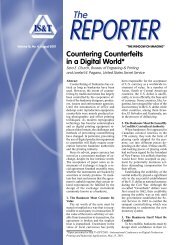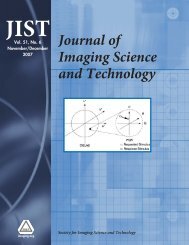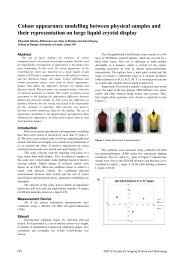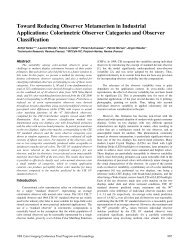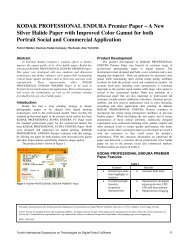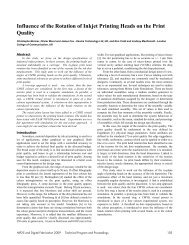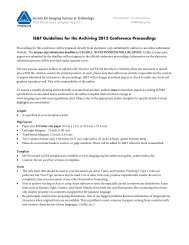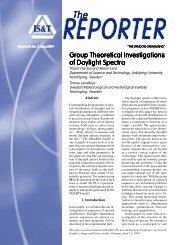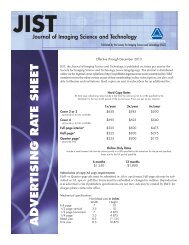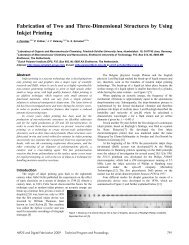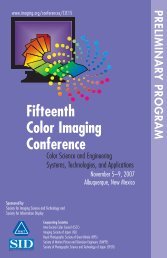JIST - Society for Imaging Science and Technology
JIST - Society for Imaging Science and Technology
JIST - Society for Imaging Science and Technology
Create successful ePaper yourself
Turn your PDF publications into a flip-book with our unique Google optimized e-Paper software.
Eida, Omatsu, <strong>and</strong> Shimizu: Advanced color toner <strong>for</strong> fine image quality<br />
Figure 7. Comparison of wax dispersion <strong>and</strong> durability.<br />
silica; we call this process “preconditioning.” Then, they<br />
were pulverized <strong>and</strong> classified. The target size was 5 m.<br />
Toner samples are listed Table II.<br />
MEASUREMENTS<br />
Durability was tested by using a toner cartridge of a color<br />
laser printer <strong>for</strong> which the developing system was a single<br />
component. Toner was put into the cartridge, <strong>and</strong> the developer<br />
roll was rotated at 60 rpm without developing the<br />
toner to the organic photoconductor. Durability was defined<br />
as time when filming of the toner to the doctor blade occurred<br />
<strong>and</strong> a streak appeared in the toner layer on the developer<br />
roller.<br />
The particle size distribution was measured by a Coulter<br />
Multisizer II with a 100 m size aperture. The size of dispersed<br />
wax domains was observed by TEM. For convenience<br />
of evaluation, a cross section of the toner chip be<strong>for</strong>e pulverizing<br />
was observed.<br />
Toner was developed in a nonmagnetic singlecomponent<br />
printer whose resolution was 600 dpi. A dot image<br />
on the paper be<strong>for</strong>e fusing was observed under the microscope.<br />
Dispersion state of silica <strong>and</strong> free silica rate were<br />
measured by Particle Analyzer FT-1000 (Horiba). Circularity<br />
was measured by FPIA 2100 (Sysmex).<br />
Transfer efficiency was defined as the amount of residual<br />
toner on the photoconductor after the transfer process.<br />
Areal density on the photoconductor was controlled at<br />
0.40–0.45 mg/cm 2 . The residual toner was removed by<br />
clear tape <strong>and</strong> placed on white paper. The amount of the<br />
residual toner is defined as the difference of hue E between<br />
the residual toner sample <strong>and</strong> the blank tape on the<br />
same paper.<br />
RESULTS AND DISCUSSION<br />
Wax Dispersion <strong>and</strong> Durability<br />
Figure 7 shows wax dispersion in toners A <strong>and</strong> B. The size of<br />
the dispersed wax domains in toner A that was kneaded by<br />
conventional twin-screw extruder is very large. This indicates<br />
the twin-screw extruder cannot disperse wax finely<br />
enough. On the other h<strong>and</strong>, the dispersed size of wax of<br />
Figure 8. Result of pulverizing of toners C, D, <strong>and</strong> E.<br />
toner B was very small. Toner B was kneaded by an openroll-type<br />
kneader, <strong>and</strong> this type of kneader can knead toner<br />
at a lower kneading temperature, which means toner is<br />
kneaded more strongly at a higher resin viscosity compared<br />
to the twin-screw extruder.<br />
Durability of toner B is over six times that of toner A,<br />
<strong>and</strong> is enough <strong>for</strong> practical use. This result indicates that<br />
large domains of wax decrease durability of toner because, it<br />
is thought, that such a large wax domain tends to (i) exist on<br />
the toner surface after pulverizing <strong>and</strong> (ii) stick to the doctor<br />
blade <strong>and</strong> developer roller. To avoid this problem, it is necessary<br />
to disperse wax finely in the toner; thus, toner<br />
kneaded by the open-roll-type kneader can contain plenty of<br />
wax with finely dispersed size <strong>and</strong> can yield both efficient<br />
fusing ability <strong>and</strong> durability <strong>for</strong> oilless fusing.<br />
Result of Pulverizing of Toners C, D, <strong>and</strong> E<br />
Figure 8 shows the result of pulverizing. Toner D was pulverized<br />
to 5 m size with narrow distribution successfully.<br />
Toner C, which was not preconditioned, was not pulverized<br />
to a small size, <strong>and</strong> it contains large-size particles. Toner E,<br />
which was preconditioned but kneaded by the twin-screw<br />
extruder, also was not pulverized to 5 m size. Dot image<br />
quality with toner D is as good as with typical chemical<br />
toner shown in Fig. 2. On the other h<strong>and</strong>, the dot images<br />
with toners C <strong>and</strong> E are worse because of toner scatter.<br />
These results indicate that small <strong>and</strong> narrow size distribution<br />
is necessary <strong>for</strong> fine image quality. The reason why toners C<br />
<strong>and</strong> E were not pulverized successfully is discussed below.<br />
Difference between Toners C <strong>and</strong> D<br />
In general, as toner particle size in the pulverizer becomes<br />
smaller, the adhesion <strong>for</strong>ce between particles increases; small<br />
toner particles tend to agglomerate. Such agglomerated particles<br />
cannot be given pulverizing energy efficiently, <strong>and</strong> it is<br />
difficult to pulverize toner to small size, as was observed <strong>for</strong><br />
toner C. But in the case of toner D, silica is present in the<br />
410 J. <strong>Imaging</strong> Sci. Technol. 515/Sep.-Oct. 2007




